THE LANDING
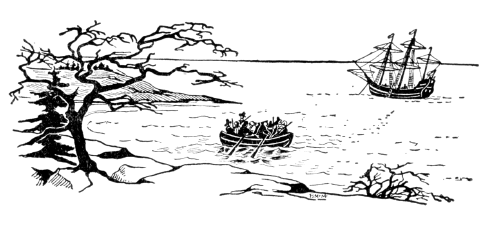

"And the heavy
night hung dark
The
hills and waters o'er,
When
a band of exiles moored their
bark
On
the wild New England shore."
|
ON the
11th of November they
anchored inside the extreme point of Cape Cod, "in a goodly and
pleasant harbour" (now that of Provincetown), compassed about by a
heavily wooded coast. Here a thousand ships might safely anchor,
sheltered from the winds and waves. Records show beyond peradventure
that the coast was at that time heavily wooded, though this seems
hardly possible in view of the present barren condition of that
locality. A name given to a point of land on an early map is Wood End,
again showing the existence of the number of trees then abounding.
The same
day sixteen armed men went
ashore in a dingy, but returned at nightfall, having seen no human
being nor found a trace of human habitation or of wild beasts.
A few days
later Myles Standish,
while on a foraging expedition and accompanied by an armed escort, came
upon a small band of Indians, who, upon observing the men from the
ship, fled precipitately and apparently in great fright.
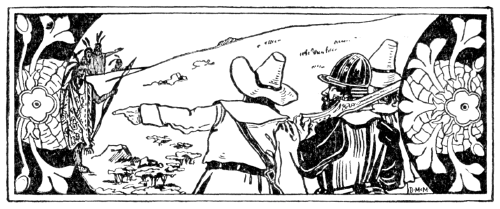
Upon
following their trail some
recent Indian graves were discovered, and in the vicinity were also
found implements of war -- clubs, arrow-heads, and spears -- which had
been left behind by the red men in their flight. A store of corn was
also found buried in the ground, which Standish and his men
appropriated forthwith to the extent of "ten heaping bushels," but
which the settlers afterward paid the rightful owners for at a "fair
rate of barter."
Before the
end of November the
second birth occurred -- Peregrine White, a daughter to William and
Susan White-while the company were still aboard the anchored vessel. At
about this time also occurred another death, that of Dorothy, wife of
William Bradford, who fell overboard from the deck of' the Mayflower
and was drowned in Cape Cod Harbor. On the 6th of December a party of
the principal men circumnavigated the bay in a small boat in search of
a permanent place to locate the settlement. They passed the night of
the 9th on a small fertile island in what was afterward Plymouth Bay,
and which they named Clarke's Island, after the mate of the Mayflower,
who accompanied them and who was altogether a more
agreeable person to their liking than any other of the navigators or
crew.
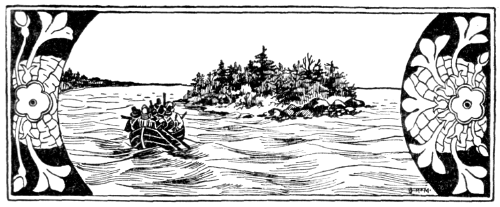
The
following day being the
Sabbath, it was kept by the little band separated from the main body
still on board the Mayflower, in true Christian
spirit, and it was likewise observed aboard the ship, under the
presiding rule of Elder Brewster, he not having accompanied the
exploring party.
The next
day, the 11th, the harbor
between Clarke's Island and the mainland was sounded, and was found to
be of a suitable depth for the safe anchorage of the Mayflower.
Upon reaching the shore they found an ample supply of
pure water, a fertile soil, and a desirable spot for the location of
their future settlement, which was immediately decided upon and
accepted.
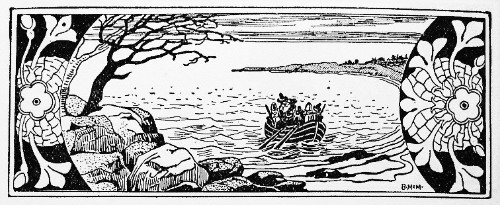
This day
(11th December, 1620,
O.S.) has always been considered and celebrated as Forefathers' Day --
the day on which the Pilgrim Fathers first landed on Plymouth Rock --
which, according to the new style reckoning, is the 21st December.
Romance
has clothed the episode of
the actual first stepping upon Plymouth Rock with some obscurity. The
circumstance, while commendable enough to warrant a gratifying
assurance, were such a thing possible, is hardly of sufficient
importance to justify a controversy as to whether the honor or
distinction belongs to Mary Chilton or to John Alden. The facts which
will generally be accepted without question are
these: The exploring party which first touched at this particular spot
was composed only of a small number of the hardy and active men of the
company, among them John Alden. "Youngest of all was he of
the men who came in the Mayflower." If this be the spot
where they first stepped on shore, it is not readily seen how the honor
could belong to Mary Chilton.
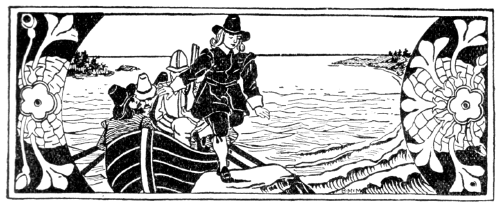
The
records do not show that any
woman accompanied the exploring party which, set out from the ship, and
which was made in an open boat at the most rigorous season of the year,
nor is it likely to suppose that there were such. Accordingly the
distinction undoubtedly belongs to Alden, regardless of the picturing
by a famous artist of Mary Chilton -- the first to set foot on Plymouth
Rock.
Soon after
the final decision as to
a location had been agreed upon the Mayflower was
towed over to her anchorage for the winter, and preparations for the
actual settlement and the transfer of the company and their belongings
were begun.
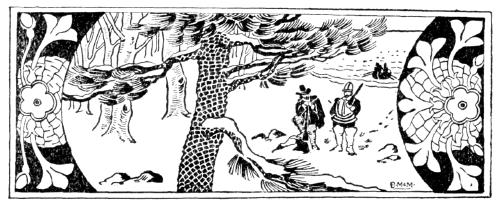
Thus it is
seen they were five
weeks aboard the ship at anchor, inside Cape Cod before their ultimate
decision to settle here and their final choice as to the precise
location. The bleak and bare New England coast at this season of the
year offering little encouragement to them in favor of their decision,
which should be credited solely to their good judgment and foresight as
to future possibilities and existing conditions.
Over
one-half of the company died
during the first winter, due probably to the effects of insufficient
food and shelter, the hardships incidental to disembarking, and the
general severity of a New England winter.
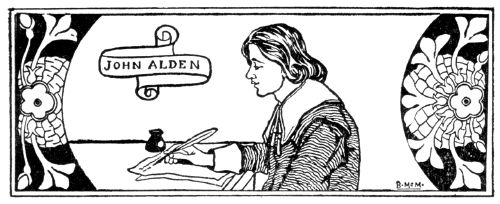
The
following individual members of
the colony became more than ordinarily prominent in the affairs of the
community, and their names are recognized by all as being influential
in forming the future customs and habits of all the other allied New
England colonies:
JOHN HOWLAND,
JOHN CARVER,
WILLIAM
BREWSTER,
EDWARD WINSLOW,
WILLIAM
BRADFORD,
ISAAC ALLERTON,
MYLES STANDISH,
JOHN ALDEN.
|
And of the women,
ROSE STANDISH,
PRISCILLA
MULLINS,
DOROTHY
BRADFORD,
MARY CHILTON,
|
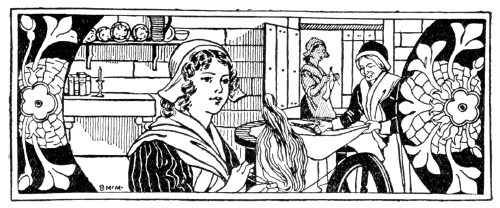
are
particularly noted as having
become famous to posterity and all good Americans alike. The part that
they, the women, took in the early affairs of the country cannot be
lightly passed over. If their responsibility was less, their burdens
were none the less light than those of the men, and their good health,
sturdy constitutions, and provident customs were responsible in a great
measure for the firm foundation on which they stood.
 Click
the book image to continue to the next chapter Click
the book image to continue to the next chapter
|

